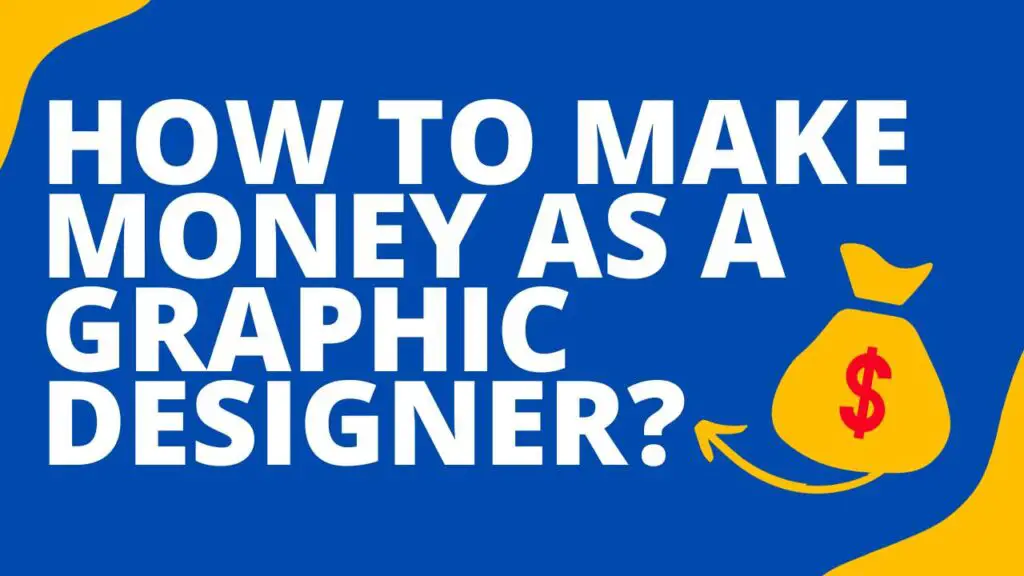THIS ARTICLE MAY CONTAIN AFFILIATE MARKETING LINKS! IN CASE YOU MAKE A PURCHASE THROUGH ONE OF THE LINKS, WE'LL GET A SMALL COMMISSION. WITH NO EXTRA CHARGES TO YOU. THANKS!!
Making money as a graphic designer requires a combination of creativity, effective marketing, and delivering valuable services to clients. Let’s explore the steps on How to Make Money as a Graphic Designer.
How to Make Money as a Graphic Designer?
Creating and selling digital products such as templates or fonts
- Identify Your Niche: Choose a specific theme or niche for your digital products. This could include website templates, social media graphics, PowerPoint templates, or unique fonts. By narrowing down your focus, you can stand out in a competitive market.
- Develop Your Products: Create top-notch digital products that are visually appealing and user-friendly. Pay attention to every detail and ensure that they can be easily customized. For font creation, consider using software like FontLab or Glyphs to design and generate your own typefaces. For templates, rely on graphic design software such as Adobe Illustrator, Photoshop, or InDesign.
- Protect Your Work: Think about copyright protection or licensing options for your digital products to prevent unauthorized use or distribution. You can utilize licenses like Creative Commons or create your own terms of use.
- Set Pricing: Conduct market research to determine competitive pricing for your products. Take into account factors like production costs, the value you provide, and the prices of similar products in the market.
- Create a Brand: Establish a strong brand identity for your digital products by designing a professional logo, attractive product packaging, and maintaining consistent visual aesthetics across all marketing materials.
- Build an Online Presence: Develop a website or leverage e-commerce platforms like Shopify, WordPress with WooCommerce, or Etsy to showcase and sell your digital products online. Ensure that your website is user-friendly and optimized for mobile devices.
- Payment Processing and Delivery: Set up secure payment processing methods such as PayPal or Stripe to facilitate smooth transactions with customers. Automate the delivery process so that customers receive their purchased digital products immediately.
- Marketing and Promotion: Devise a comprehensive marketing strategy to reach your target audience. Utilize social media platforms, content marketing, email campaigns, and consider investing in paid advertising. Collaborate with influencers or bloggers in your niche to promote your products effectively.
- Customer Support: Provide excellent customer support by promptly responding to inquiries and addressing any concerns or issues raised by customers. Offer clear instructions on how to use your digital products efficiently.
- Gather Feedback: Encourage customers to leave reviews and feedback on your website or chosen platform. Positive reviews can enhance your credibility and boost sales.
- Regular Updates: Keep your digital products up-to-date and compatible with the latest software versions to ensure continued value for customers.
- Expand Your Product Line: As your business grows, consider expanding your product offerings to meet evolving customer demands and keep up with emerging trends in the industry.
- Legal Considerations: Consult legal professionals if necessary, especially when selling fonts, to ensure compliance with copyright laws and regulations.
- Analytics and Tracking: Monitor sales figures, website traffic data, and customer behavior using analytics tools. This data will provide valuable insights that can help you make informed decisions for business improvement.
Selling digital products can generate passive income once you’ve established a solid customer base. Remember that effective marketing strategies and prioritizing customer satisfaction are key factors in building a successful digital product business. Continuously refine your products and marketing approaches to attract new customers while retaining existing ones.

Freelancing
Freelancing in the field of graphic design offers the freedom to work independently on a variety of projects for clients. If you’re interested in pursuing freelance graphic design, here’s a step-by-step guide to help you get started and navigate the world of freelancing successfully:
- Develop and Showcase Your Skills: It’s important to have a strong foundation in graphic design skills, including proficiency in software like Adobe Creative Suite. Build a diverse portfolio that showcases your best work. Include different types of projects to demonstrate your versatility and expertise.
- Establish an Online Presence: Create a professional website that highlights your portfolio, services offered, contact information, and a brief bio. Utilize relevant social media platforms such as LinkedIn, Behance, Dribbble, or Instagram to showcase your work and engage with potential clients.
- Define Your Niche: Consider specializing in a specific area within graphic design such as logo design, web design, branding, or print design. This specialization will help you target a specific audience effectively.
- Determine Your Rates: Research industry-standard rates based on your level of experience and expertise. Decide whether you’ll charge hourly, per project basis or on retainership. Clearly communicate your pricing structure when discussing projects with clients.
- Create Contracts: Develop standard contracts that outline project scope, deliverables, timelines, payment terms and other relevant details. Contracts protect both you and your clients’ interests.
- Market Your Services: Leverage your online presence to promote your services by sharing your portfolio along with client testimonials and case studies. Reach out to your network including friends and family members to inform them about the freelance graphic design services you offer. Consider running targeted online advertising campaigns to expand your reach to potential clients.
- Freelance Platforms: Sign up on popular freelancing platforms such as Upwork, Freelancer, Fiverr or 99designs. These platforms can help you find clients and projects. Create an engaging profile on these platforms that effectively highlights your skills, experience and portfolio.
- Client Acquisition: Respond promptly to inquiries and job invitations while maintaining a professional tone in your communication. Customize your proposals for each client by showcasing how you understand their specific needs and can meet their project objectives effectively.
- Project Management: Once you secure a project, create a project timeline and communicate it clearly to the client. Utilize project management tools like Asana, Trello or Basecamp to stay organized with tasks, deadlines and communication throughout the project.
- Deliver High-Quality Work: Collaborate closely with your clients to ensure that you meet their expectations. Provide regular updates on the progress of the project and actively seek feedback along the way.
- Invoice and Payment: Send professional invoices that include clear payment instructions. Consider using invoicing tools or platforms that facilitate electronic payment methods for convenience.
- Client Relationships: Build strong relationships with your clients by being responsive, professional, and reliable in all interactions. Request testimonials or referrals from satisfied clients as this can help attract more business opportunities.
- Continuous Learning: Stay updated with design trends and software updates to remain competitive in the field. Attend webinars, workshops or courses that can enhance your skills further.
Remember that freelancing can be unpredictable at times with fluctuations in workload and income. It’s important to manage your finances effectively, set clear boundaries for work-life balance, and maintain a consistent work ethic for long-term success as a freelance graphic designer.
Participating in design contests and competitions for cash prizes
Participating in design contests and competitions can be an exhilarating way for graphic designers to demonstrate their talent, gain recognition, and potentially win cash prizes. Here are some steps to help you get started:
- Find Suitable Contests: Seek out design contests and competitions that align with your interests, skills, and expertise. Various websites and platforms host such contests, including 99designs, DesignCrowd, Behance, among others.
- Review Contest Guidelines: Thoroughly read the contest guidelines and rules. Pay close attention to submission requirements, deadlines, eligibility criteria, and any specific design brief provided by the contest organizer.
- Create a Winning Entry: Begin by fully understanding the design brief. Conduct research on the target audience, competitors, and other relevant information. Tap into your creativity and design skills to produce a distinctive and captivating entry that effectively addresses the contest’s requirements. Consider offering multiple design variations if permitted while ensuring that your submission is visually appealing and showcases professionalism.
- Submit Your Entry: Follow the submission instructions outlined by the contest organizer meticulously. Make certain that your entry complies with all specified requirements such as file formats, dimensions, and any other technical details.
- Promote Your Entry: Encourage friends, family members, as well as social media followers to vote for your entry if public voting is part of the contest’s process. Share your entry on social platforms and within relevant design communities.
- Be Patient and Persistent: Winning design contests can be highly competitive; therefore it is important not to become disheartened if immediate success eludes you. Continue entering contests while continuously enhancing your skills.
- Protect Your Work: Exercise caution when sharing high-resolution files or original design files until you have verified the legitimacy of the contest. Some contests may have questionable terms and conditions that could compromise your rights.
- Learn And Improve: Irrespective of whether you win or not, view each contest as an opportunity for growth and development as a designer. Analyze feedback and critiques, utilizing them to enhance your future entries.
- Consider Pro Bono Contests: Certain contests are organized for non-profit organizations or causes. Participating in such contests allows you to contribute to a meaningful cause while simultaneously showcasing your skills.
- Legal Considerations: Be aware of the rights you retain or forfeit when participating in a design contest. Carefully read and comprehend the contest terms and conditions, particularly those relating to intellectual property rights.
- Network And Collaborate: Design contests often bring together talented designers. Networking with fellow participants can lead to collaboration opportunities and valuable connections within the design industry.
- Manage Your Time Wisely: Avoid allowing contest participation to consume all your time and energy. Strike a balance between entering contests and engaging in other freelance work or personal projects.
Remember that winning design contests can be highly competitive, and not every entry will result in a cash prize. Nonetheless, it can be an enjoyable and valuable experience that challenges you, showcases your skills, and increases exposure within the design community. Over time, participating in multiple contests can assist you in refining your design skills while building a stronger portfolio.
- Make Money as a Graphic Designer
- How to make money as a Graphic Design Student
- How to Make Money as a Freelance Graphic Designer?
Offer design services on platforms like Fiverr or Upwork
If you’re looking to offer design services on platforms like Fiverr and Upwork, it can be a great way to find clients and build your freelance graphic design business. Here are some steps to get started:
- Create an Impressive Profile: Sign up on Fiverr and/or Upwork and make sure to create a professional profile. Use a high-quality profile picture and write an engaging bio that showcases your skills, experience, and what you can bring to the table for clients.
- Clearly Define Your Services: It’s important to clearly outline the design services you’re offering. Be specific about the types of projects you specialize in, whether it’s logo design, web design, branding, or illustration.
- Set Your Pricing Structure: Decide on your pricing structure for your services. You can choose to charge clients on an hourly basis, per project, or based on the complexity of the work involved. Make sure your rates are competitive yet reflective of your expertise.
- Showcase Your Best Work: Build an impressive portfolio that showcases your best work. Include a diverse range of projects that demonstrate your skills and expertise in various areas. High-quality visuals and detailed descriptions will help attract potential clients.
- Craft Compelling Gig Descriptions: Take the time to create clear and captivating gig descriptions for each of your services. Highlight what sets you apart from others in the field and how your services can benefit potential clients.
- Optimize Your Keywords: Incorporate relevant keywords into both your gig titles and descriptions to improve visibility in search results. Research popular search terms within your niche and use them organically throughout.
- Start Small & Gather Reviews: In the beginning stages, take on smaller projects in order to establish a positive reputation within the platform community by gathering client reviews along the way – Positive feedback will help attract more clients down the line.
- Be Responsive & Professional: Always respond promptly to client inquiries/messages while maintaining a professional and attentive demeanor. Setting yourself apart from competitors in terms of communication can go a long way.
- Provide High-Quality Work: When you secure a project, ensure that you deliver top-notch design work within the agreed-upon timeframe. Meeting or exceeding client expectations is essential for building a strong reputation.
- Request Feedback & Reviews: After completing a project, kindly ask your clients for feedback and reviews. Positive reviews will boost your credibility and attract more clients to your services.
- Upsell Additional Services: Increase your earnings by offering add-on services or upgrades for each project. For example, you can offer source files, faster delivery, or revisions for an additional fee.
- Manage Your Finances: Keep track of your earnings, expenses, and taxes associated with your freelance work. Consider using accounting software or seeking professional help to manage your finances effectively.
- Stay Informed & Improve: Stay updated on design trends and industry news to enhance your skills continually. Continuous improvement is key to staying competitive in the market.
- Maintain Professionalism & Reliability: Uphold a professional work ethic by delivering projects on time and handling any issues or revisions professionally. Transparency with clients is crucial as well.
- Promote Your Services: Take advantage of social media platforms, personal websites, or email marketing to promote your services outside of the platform itself. Directly attracting clients can expand your opportunities for growth.
Remember that building a successful freelance design career on platforms like Fiverr and Upwork may require some time and dedication. However, with an impressive portfolio and excellent client service, you can gradually grow both your client base and income over time.

Teaching graphic design courses online or in-person
When it comes to sharing your expertise in graphic design through teaching, whether online or in-person, there are a few important factors to consider. Perplexity and burstiness play a crucial role in creating engaging and authentic content that doesn’t have the statistical signature of machine-generated text. By incorporating storytelling techniques, vivid adjectives, and emotional expressions, you can ensure that your content sounds genuine and relatable.
To get started with teaching graphic design courses, follow these steps:
- Establish Your Expertise: Make sure you have a strong foundation in graphic design principles, software proficiency (such as Adobe Creative Suite), and knowledge of industry trends.
- Create a Curriculum: Develop a well-structured curriculum that covers the fundamentals of graphic design, including topics like typography, color theory, layout design, and digital illustration. Consider offering specialized courses in web design, logo design, or branding.
- Choose a Teaching Format: Decide whether you prefer teaching online or in-person based on your target audience’s preferences and your available resources. Online Teaching: Reach a global audience with flexibility in scheduling while keeping overhead costs low. However, be aware that online delivery may require technical skills. In-person Teaching: Connect more directly with local students but keep in mind that this format may have limited reach and higher overhead costs for physical facilities.
- Plan Your Course Content: Break down your curriculum into individual lessons or modules with clear learning objectives, assignments, and assessments.
- Create Engaging Teaching Materials: Develop visually appealing slideshows, video lectures with captivating content delivery style along with assignments and handouts that support the learning objectives.
- Choose the Right Platform for Online Courses (Optional): If you opt for online teaching platforms like Moodle or Canvas Learning Management Systems (LMS) or dedicated platforms like Teachable, Thinkific or Udemy ensure it aligns with your course delivery requirements.
- Building an Effective Website (Optional): In case you choose online teaching, consider creating a professional website to promote your courses, showcase your expertise, and handle enrollment and payments.
- Determine Pricing and Enrollment: Set the pricing for your courses based on factors like course content, market rates, and your experience. Decide on the enrollment and payment process, whether it’s through your website or a course platform.
- Market Your Courses: Promote your courses through various channels such as social media platforms, email marketing campaigns, personal networks, or relevant online communities and forums.
- Deliver Your Course: Teach with enthusiasm and clarity while providing prompt feedback and support to your students.
- Gather Feedback: Encourage students to provide feedback on both the content of the course and its delivery. Utilize their input to improve your teaching methods and enhance course materials.
- Continuous Learning: Stay updated with design trends and teaching techniques by attending workshops, webinars, conferences that improve both your design skills as well as instructional abilities.
- Offer Certification (Optional): Consider offering course completion certificates that can enhance the credibility of your courses and attract more students.
- Legal Considerations: Address legal matters such as copyright issues, terms and conditions along with privacy policies to safeguard your content as well as protect the rights of students enrolled in your courses.
- Expand Your Offerings: As you grow in the teaching business consider diversifying course offerings by introducing advanced-level courses or collaborating with other experts in order to expand reachability
Teaching graphic design not only allows you to share knowledge but also helps others develop their skills while generating income for yourself.
Keep in mind that building a successful teaching business may take time so be patient while remaining open to feedback from students which will help you deliver value effectively.







